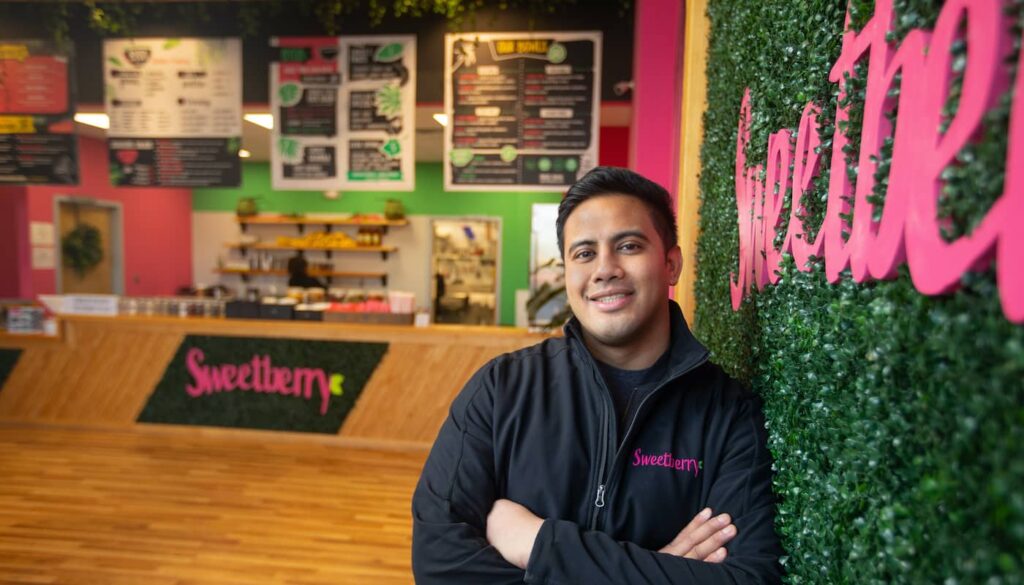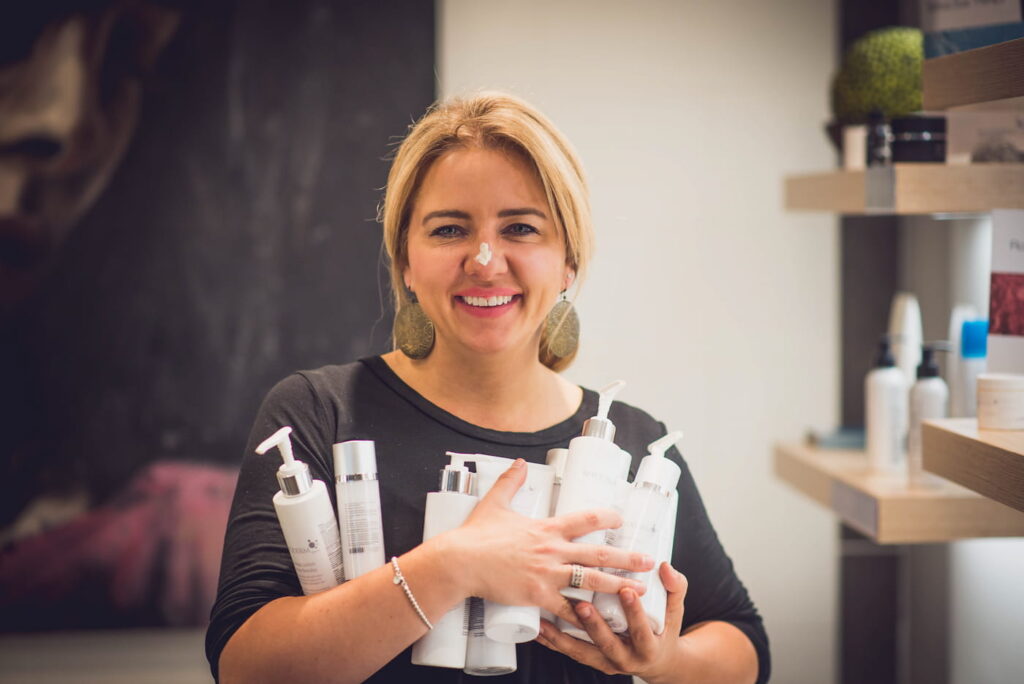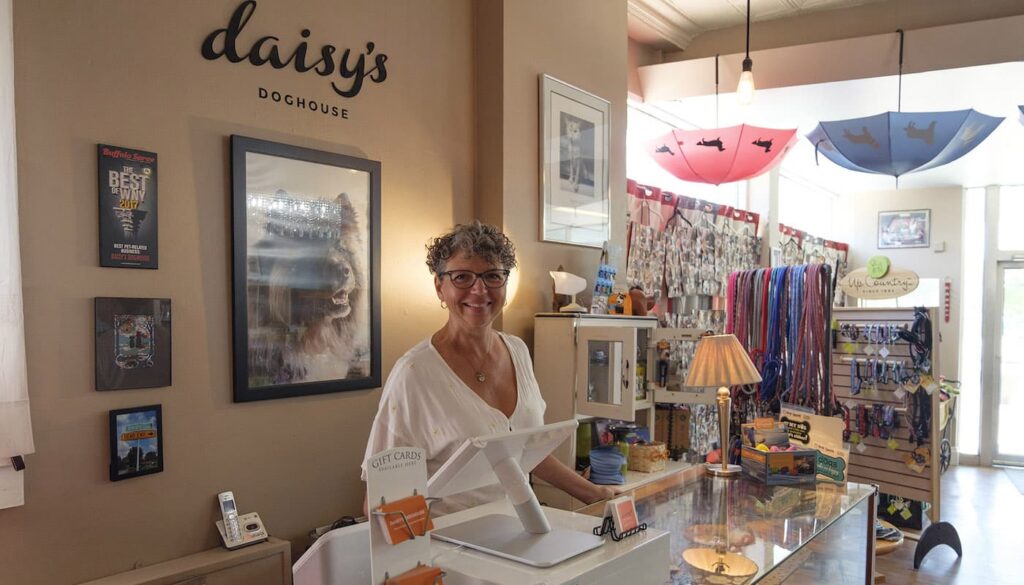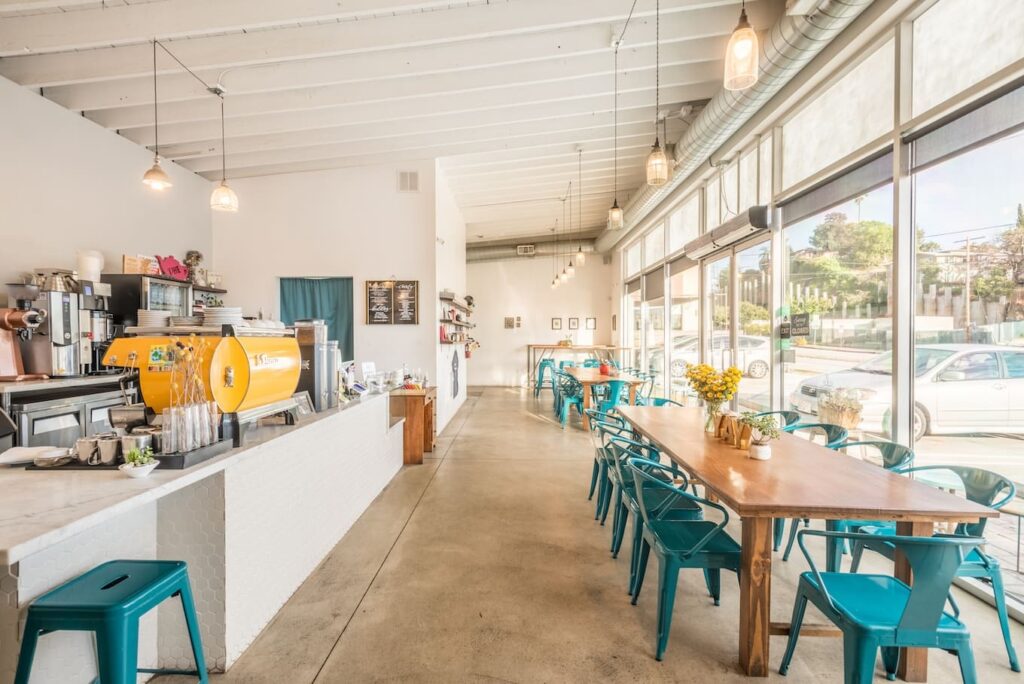Introducing new products can be difficult since customers often stick with what they know best.
However, by offering new items as rewards, you incentivize your customers to explore your product range. In fact, rewards help grow revenue by shaping buyer behavior. They introduce new products to your existing customers, and they can help increase the likelihood that customers will return. Ultimately, these patterns help you expand your customer base by reaching more customers with more of your products.
There are a few ways you can use loyalty programs to introduce customers to new items and make your product launch a success:
Create itemized rewards
Item-specific rewards give you the chance to introduce your customers to something they wouldn’t normally try. Successful item-specific rewards can encourage repeat purchases alongside customers’ usual orders by providing a taste for more.
Offer bonus points for the launch of your new products
You can offer customers bonus points when they buy new products in your store during an introductory period. This encourages shoppers to be more adventurous, while accumulating loyalty points with you. Loyalzoo’s double points feature lets you decide the exact timing for when you would like to offer this bonus. Pair bonus points with a promotion to simultaneously showcase new products and generate interest.
Use powerful promotions
One of the best ways to let your customers know about a new product is by sending a special promotion and offering a discount. Send image-rich promotions to make it easier for customers to discover new items and encourage them to make a purchase.
Loyalty programs can be a powerful tool for introducing customers to new products and categories. By incentivizing customers to try something new, you can help increase revenue, retain customers, and expand your customer base.
Visit the Clover App Market to learn more about setting up loyalty programs at your business with Loyalzoo.
TRY LOYALZOOYet, opening a retail store is also a lengthy process with surprises and challenges along the way. Whether you’re in the ideation phase or getting serious about starting a small business, this guide covers some of the steps to opening up a store to help guide you through the process.
Steps to opening a store
Where should you start when it comes to opening a retail business? Is it learning the legal requirements for opening a retail store? Choosing brick-and-mortar, eCommerce, or a hybrid approach? Or searching for the perfect products to sell?
Read on to discover the steps to opening a retail store.
Create a business plan
The best place to start is your business plan, because it serves as a road map to opening your store. A good business plan can help save decision-making time later on by answering many of the questions small business owners have.
Business plans define the business mission, vision, goals, and scope. These documents provide a framework for business growth. By following the plan, business owners can grow their retail shop in alignment with their values and mission.
A business plan isn’t a one-and-done document. Instead, it is a living document that can evolve over time, alongside the business.
A typical business plan outlines things such as:
- Retail products: What product mix will your store sell? Are you creating these products yourself or purchasing inventory from vendors? Here is where you’ll list out the retail niche, product mix, and any vendors and suppliers you plan to work with.
- Target market: Who is your customer base? What are they looking for in products within your niche?
- Marketing strategies: Where do your customers hang out, physically and online? How will you connect with them, introduce your brand, and get them to shop with you? Your marketing strategies should connect to the target audience you identified above.
- Store location and layout: What neighborhood does your store belong in? What will the physical store look like? How big does it need to be? How will merchandise be displayed?
- Partnerships and reach: What strategic partnerships will broaden your brand’s reach? How will your business partner with other local businesses or community organizations, such as a Chamber of Commerce?
- Employees and staff: What are your store’s staffing needs by role, time of day, or time of year? How will you recruit and train employees?
- Finances: What is your business’s financial forecast? When you’re starting from scratch, this involves a lot of guesswork. But it’s worth going through the motions to get an idea of your overhead costs (such as rent, inventory, and wages) and income potential.
Estimate startup costs
It’s normal for a retail store to have high startup costs. You’ll need to find the business location, pay rent, invest in signage and shelving, purchase inventory, hire staff, get a website up and running, and do a big marketing push. This all happens before you’ve even sold a product.
Ideally, the launch is a success, and the shop is able to recoup its startup costs and earn revenue.
Still, you’ll want to estimate startup costs to the best of your abilities. Doing so helps you understand whether expenses fit within your budget. If you launch without an estimate of startup costs, you run the risk of overspending.
Typically, retail store startup costs include:
- Rent/location: In high-traffic, high-value neighborhoods, the rent prices will be higher. This can be offset by the volume of customers.
• Merchandise: Merchandise cost represents the cost of your inventory. For a retail store, these are physical items you are making yourself or purchasing from other suppliers.
• Operational costs: Operational costs include any costs necessary to keep the business running. Utilities, such as electricity and heat, fall under operational costs. So do hiring, training, and managing employees.
• Marketing budget: To introduce your new shop to potential customers, you’ll need to create a marketing plan that includes a marketing budget.
• Technology: Physical stores need technology, including a retail point of sale (POS) solution that manages inventory and processes payments and refunds. Retail stores may also need a website, especially if the plan is to sell products online as well as in-store. And, don’t forget about other business management software such as employee scheduling, payroll processing, and bookkeeping programs.
Get funding and forecast financials
While some entrepreneurs can use bootstrapping as an option (or the process of growing a business with very limited resources), most business owners rely on startup funding to launch. Traditionally, this funding can come in the form of a bank loan, but alternatives can include credit cards, crowdsourcing, and Small Business Administration (SBA) loans, just to name a few.
To obtain a bank loan or business credit card, you’ll first need to get your finances organized.
If you made financial projections in the business plan, the startup costs you estimated will come in handy when you approach lenders.
Forecast the financials for your business by looking to local market data and statistics relevant to your niche to set standards on income after starting a brick-and-mortar store.
READ: Why forecasting is crucial to your business plan
Register your business
There are some legal requirements for opening a retail store that you need to follow before you can open your doors. You’ll need a business name and legal structure in order to register your business. Registration happens through your state’s Secretary of State website. After registration, you’ll want to obtain an employer identification number (EIN) from the Internal Revenue Service (IRS). Think of this as a Social Security number for your business entity.
States have different legal requirements for business insurance, permits, and licensing. Double check with state and county websites to make sure you’ve ticked all the boxes. We’ve created some content for starting a small business in specific states. See if we have your state here.
Find an ideal location
Like the old adage says, it’s all about location. The right location can naturally draw in your desired audience and help propel your business to a successful launch. This resource on finding a business location can help you understand what to look for.
Create merchandise vendor partnerships
What do you need to open a store? Merchandise.
Buying wholesale for a small business is one way to approach merchandising. Some small business owners prefer to take a “buy local” or “support small business” approach to merchandising.
Regardless of which tactic you take, you’ll want to order sample merchandise, vet it for quality, agree on pricing, and understand order minimums. Once you and your vendors are in agreement, formalize the arrangements using partnership agreements.
Set up and integrate payment systems
As mentioned, retail stores need to ring up transactions and accept payments. Rather than get one technology for managing inventory and another for handling sales, why not get an all-in-one POS system designed for retail operations?
Retail POS systems handle all the financial transactions, from sales to returns to exchanges. They provide at-a-glance insight into inventory levels and sales trends, so you know when it’s time to reorder. They also give you the option to manage staff, schedule employees, and process payroll.
These days, many retail businesses also rely on online sales. Since an eCommerce website can accept orders 24/7, it supports the store by providing another pathway to sales. For this reason, it’s wise to choose a retail POS that can handle both in-person and online sales.
Once you select the right POS for your store, you’ll need to set it up on the back end. Add inventory SKUs and quantities. Set up par alerts to be notified when inventory levels drop below a minimum. Input employees, schedules, and payroll information to process paychecks, schedule employees, and keep the store running smoothly.
Open your store to the public
Once you’ve designed, stocked, and staffed the store, it’s time to have a formal opening!
Use your marketing plan to promote your store, generate buzz, and let customers know you exist. This way, on the day you open your doors, your community will be ready to support your new store.
Starting a retail business is a lot of work. However, you don’t have to go it alone. When it comes to learning how to open a retail store, Clover has a wide range of business management solutions geared towards helping small businesses run their entire operation from accepting payments to managing employees to engaging with customers.
Reach out to a Clover Business Consultant to explore solutions today.
CONTACT SALESThis information is provided for informational purposes only and should not be construed as legal, financial, or tax advice. Readers should contact their attorneys, financial advisors, or tax professionals to obtain advice with respect to any particular matter.
In this Meet the Merchant post, we feature 8 local merchants in the Midwest who manage and grow their businesses with Clover.
Illinois
Gonzo’s Rock & Roll Pizzeria, Sandwich, Illinois
It was a nickname and a talent for playing bass guitar that led Arturo Garza to name his restaurant Gonzo’s Rock And Roll Pizzeria. After volunteering for several years as part of a stage crew at Aurora’s internationally renowned blues festival, Arturo decided to bring the local music scene–and local musicians–to his restaurant. With its high ceilings and wood floors, the restaurant is an intimate space with a rich, vibrant sound–a place where the tight-knit community of musicians knows and supports each other. Be sure to stop in for great pizza and a good tune.
Michigan
London Beauty, Brighton, Michigan
While working in fashion and retail in New York, Kathleen London noticed a gap in the beauty industry–no one was offering clean makeup that performed well. And so began the concept for London Beauty. With a broad line of US-made retail products, Kathleen’s business offers eco-conscious luxury paired with affordable convenience. What’s more, over 85% of its inventory is made by female-owned businesses. If you’re in Brighton, Michigan, visit Kathleen’s shop.
La Gelati, Dearborn Heights, Michigan
Hussein Saad, Zeinab Cherkaoui, and Yousef Khalaf started La Gelati in Dearborn Heights, Michigan in 2017. It’s specialty is homemade ashta, a smooth, hand-pulled ice cream with a silky texture akin to gelato. Based on a very old ice cream tradition that started in what is now Syria, La Gelati’s ashta is popular with locals and is sold in over 30 retail locations. If it’s too chilly out for something cold, no worries. La Gelati offers other delectibles like crepes, waffles, boba tea, and more.
Missouri
Fannies West African Cuisine, Kansas City, Missouri
Growing up in Liberia, West Africa, Fannie Gibson opened Fannie’s West African Cuisine to the public in April 2018. And ever since, she’s shared her grandmother’s traditional recipes–and her love of cooking–with people from all walks of life. Fufu, (a dumpling made out of cassavas, yams, and plantains), jollof (mixed vegetables and tomato sauce), and puff (small doughnuts, sweet enough to eat alone, and served with Fannie’s signature pepper sauce) feature on a plant-based menu–and are customer faves. If you find yourself in Kansas City, be sure to drop in.
Nebraska
Big Mamas Kitchen, Omaha, NE
Big Mama’s Kitchen and Catering gained international recognition after being featured on the Food Network’s Diners, Drive-ins and Dives. Known to her family and friends as “Big Mama,” founder Patricia Barron learned to cook from her grandmother, Lillie. In fact, it’s her grandmother’s biscuit recipe that’s still used today in the restaurant, along with hundreds of other recipes handed down to Big Mama from her grandmother. Owner Gladys Harrison, Patricia’s daughter, now runs the family business and shares her mother’s passion for food that serves and strengthens the local community. If you’re in Omaha or the surrounding area, visit Big Mama’s Kitchen for good food and good company.
Ohio
Crystal Marie’s Divine Designs, Cincinnati, Ohio
After getting her start in a high-end salon, Crystal Marie Render opened Crystal Marie’s Divine Designs. An upscale salon, Crystal Marie’s salon adds a touch of crystal, leather, and luxury to the Cincinnati salon scene. Dedicated to educating her clients on hair care, Crystal Marie invests time in teaching her clients how to maintain their hair properly. If you’re looking for a luxurious salon day in Cincinnati and tips on maintaining your style, visit Crystal Marie’s Divine Designs.
Destiny Farm Cattle, Medina, Ohio
Nestled in a valley with beautiful pastures and a wooded river, Destiny Farm Cattle is a small, independent farm in Medina, Ohio. Dedicated to raising grass-fed cattle without hormones, antibiotics, or steroids, owner Hendrick Leibrandt is a champion for sustainable and humane farming, free of pesticides. Destiny Farm Cattle have made healthier meal options for its community simple–locals can order farm products online and pick up their order, fresh from the farm. If you’re in the Medina area, take in the beautiful countryside and clean eats from Destiny Farm Cattle.
Wisconsin
Physical Therapy of Milwaukee, Milwaukee, Wisconsin
A childhood rollerblading accident introduced Dr. Sylvestra Ramirez to the world of physical therapy. Years later, she founded Physical Therapy of Milwaukee (PTM), an award-winning team of physical therapists who specialize in pain management and mitigation, as well as work and sports injuries. Committed to giving back to the community, the PTM team offers service internships for physical therapy students, volunteers in the community, and collaborates with local senior centers. If you’re in Milwaukee and need physical therapy, look up Physical Therapy of Milwaukee.
Want to learn more about other Clover merchants across North America? Read more Meet the Merchant stories here for real-life stories of small businesses in action all over the country.
Want to be featured in this series? Fill out our questionnaire, and if we can include you in a future interview cycle, we’ll send you an invitation!
Now, we’d like a few photographs of you and your business to include in your article and help promote it. Be sure to refer to this guide as you prepare and submit your photos.
We’d like …
- 1-2 clear photos of you alone in landscape mode and taken by someone else–selfies don’t work.
- 2-4 pics of your business in action, your product, and/or your space. It’d be great if you could include 1 pic of you or someone at your business with your Clover device.
Your photos should be …
- At least 1400 x 800 pixels and 140KB–bigger is even better. What’s more, most smartphones can handle taking photos of this size.
- Taken by someone else–selfies don’t work.
- Taken in natural light, if possible. Otherwise, have warm light directed towards you, not towards the camera lens. Be sure to check the photo settings, turn off the flash, and save the photo as the largest file you can.
Submit your photos …
- To CloverMTM@gmail.com. Or, if you prefer, you can request a private link to a Google folder where you can upload your images.
- Within a week of your interview.
Check out these examples
Peruse these merchant photos to learn more about what we’re looking for. And, be sure to check out these tips on how and why your business needs great photos.
Business Owner Photos

Holy Rolly Charleston
- Focuses on the business owner against a simple background
- Taken outside, in natural light
- Landscape orientation–not portrait orientation and not a selfie
- Taken by another person, perhaps a professional photographer

Sweetberry
- Captures the business owner and the business
- Taken inside in warm lighting–looks natural!
- Landscape orientation
- Taken by another person, perhaps a professional photographer

Derm.ca
- Although taken inside, the lighting is warm
- Showcases the business owner and her business (and her fun personality!)
- Taken by another person, perhaps a professional photographer
Business and Product Photos

Daisy’s Doghouse
- Shows the business owner in her business–with a Clover device
- Landscape orientation
- Taken by another person

Kouign Cafe
- Showcases the product (delish!)
- Taken by a photographer

Found Coffee
- Showcases the shop in warm, natural lighting
- Landscape orientation
- Taken by a photographer
Education is a core mission of many small businesses. And many of the SMB owners we’ve featured view education as a vital component of their work. While September represents a return to the classroom, we’re looking beyond traditional institutions of learning and highlighting some educational initiatives that these five small businesses are facilitating right in their own communities.
The School – Creative Arts Education
Lindsay Duncan and Krystal Ferguson love teaching subjects not typical to K-12 education. The co-owners of The School – Creative Arts Education bring their backgrounds in performance—theater, dance, aerial arts, gymnastics, and parkour—into the classroom.
“We got a taste of the industry, the way it actually is. And that’s what we wanted to bring to the kids. Give them access to industry professionals coaching with real-world experience in a studio setting, ” share owners Duncan and Ferguson.
When the transition to virtual classes became a reality across the world, Duncan and Ferguson knew they needed to offer high-quality, competitive virtual education to keep their business open. In doing so, they carefully balanced the individual needs of their students with their bottom line.
“We know that virtual classes don’t work for everybody, so we really wanted to provide flexibility to our clients. If a student was doing an in-studio class when we shut down, we gave them an option to put their account on hold, take a credit, or take a refund if they needed it. There are so many options for kids’ programming in the virtual space, [but] we offer something you can’t get by using an app or watching a YouTube video—a personal connection with an actual dance teacher.”
ABC Fitness Connection
The folks at ABC Fitness Connection use their platform as a community resource to address wellness issues beyond physical health. Owner, Tammy L. S. Wright, explains the impetus behind their Power Women Initiative: ”In our business we focus on the physical aspects of wellness, but addressing these issues often brings up psychological barriers we all face when taking care of ourselves…I wanted to help women not only physically, but also mentally, spiritually, emotionally, and environmentally.”
Women, in particular, Wright believes, need space to explore their power and strength. Guest speakers join her to provide educational resources on a variety of topics: social, financial, emotional, environmental, intellectual, and physical. “But it’s not just a workshop,” she stresses. “It’s active tasks that help us heal and strengthen. The goal is to finish the year with a celebration because we’ve grown in each one of those dimensions.”
Cupcake Collection
Mignon Francois, owner and founder of the Cupcake Collection, doesn’t easily forget her journey to becoming a nationally-renowned baker. Through sharing her story and her pathway to success and influence, she gives back to programs that support education. Francois serves on the board of the Nashville Entrepreneur Center, which provides mentoring and scholarships to young people in business—a program that she herself went through.
“I felt it was important to give back to some of the programs that have helped me,” she shares. “They taught me the things I needed to know—what a profit-and-loss statement was and how to work with balance sheets and things like that. Now I extend my hand to help so that other people can learn.”
Francois also funds scholarships at Tennessee State University. She is still in awe of being able to support young students whom she’s never even met.
“I always want to help people discover their own entrepreneurship story,” Francois explains. “For me, that’s what success looks like: being a lighthouse in the community to show others what good business looks like and illuminating the way for others. It’s so important for entrepreneurs to know what they can do if they just believe.”
Unspoken Smiles Foundation
Jean Paul Laurent, founder of the Unspoken Smiles Foundation, describes himself as a ”social entrepreneur.” Part of his work providing access to oral hygiene care in underserved communities includes educating young dental professionals through a leadership council.
“[Our] leadership council focuses on regular participation, providing for young professionals to contribute cash, resources, or their expertise on a monthly basis,” shares Laurent. “We expect this membership to grow over the next couple years. We’ve already added a lot of young members to our roster.”
Laurent saw a silver-lining when schools were shuttered last spring—the opportunity to connect these young dental professionals with children on a much larger scale. He explains: “Right now we are beginning the process of regional scaling with the long-term goal of virtual classrooms that can disseminate our message and help improve the oral health and status of millions of children. [We seek] to connect career role models/Fellows over video chat to facilitate inclusive learning opportunities for children and youth during this period of sudden and unprecedented educational disruption. As parents are now forced to look at options for teaching and learning approaches, Unspoken Smiles has developed a more open and flexible virtual oral health education for the future.”
Harlem Doggie Day Spa
For Brian Taylor, owner of Harlem Doggie Day Spa, conducting business virtually wasn’t a viable option. Early in the pandemic, the dog grooming industry was overwhelmed by the simultaneous influx of pet adoptions and shutdown of most in-person services. While Taylor was able to maintain one-on-one grooming with contactless payment and curbside pickup, he wanted to do more—particularly to support the Black community of groomers and pet owners. So, he launched the Pandemic Pup Relief Tour.
All in all, the tour covered six cities, enlisted 80 local, volunteer groomers and trimmers, and provided free grooming services to over 600 dogs.
“Pet grooming and pet care are industries not traditionally associated with Black professionals in this country,” Taylor explains. “In addition to providing the minority of Black groomers with more of a platform, we are also hoping to reach out to more Black kids who don’t know that there’s a career for them in the animal industry.”
In assembling a diverse team of volunteers, Taylor noted that the variety of experience levels—from 20-year groomers to newcomers—was beneficial for all.
“There was a lot of continual education going on where the experienced groomers would help the less-experienced groomers technically, or give them business advice on everything from marketing to pricing structures,” says Taylor. “The opportunity to teach, share and learn was definitely one of the highlights of the tour that inspired a culture of team spirit and community. That was a statement we really wanted to make with this tour. ”
As we celebrate the classroom this month, join Clover in thanking all our merchants who support and provide educational resources to their communities. We’re grateful for the essential work you do!
Read more of our Meet the Merchant stories for real-life stories of small businesses in action all over the country. Want to be featured in this series? Fill out our questionnaire, and if we can include you in a future interview cycle, we’ll send you an invitation!
Taking advantage of increased bandwidth now can mean smoother sailing and less stress as fourth-quarter spending revs back up.
Start with the big picture
A DIY mentality is totally understandable, and even expected, when running your own business. But how much of what’s on your daily agenda could be delegated, automated, or eliminated all together? Write down what you do each day, and note the tasks that absolutely require your attention and those that may not.
There are many ways to streamline the process of doing business that make life easier and more productive. Check out 10 easy-to-use strategies that can streamline the process of doing business and make your life easier and more productive.
Spoiler alert: Many of the apps on our list could significantly free up your time.
1. Hire the help you need
Many businesses are eagerly looking to grow their teams. Indeed Employer: Recruit, Hire by Indeed allows you to post, edit, and utilize templates to seek appropriate candidates, all without stepping away from your Clover POS.
2. Make scheduling a breeze
The Time Clock and Schedule Clover apps work in tandem to make quick work of staff scheduling and managing time-off requests. They could prove especially useful in the summer months.
3. Automate payroll
Paying employees on time is the mark of any good business owner. The Gusto app automates and accelerates payroll, taking an essential, recurring task off your plate.
4. Facilitate workday communication
Even in a small-business setting, calling out to your team from across the room may not be the most efficient way to communicate. Chat App by SPS allows staff to message between devices, for quick and easy sharing of information across front and back of house.
5. Tap your own team’s expertise
It’s easy to believe you know everything there is to know about your business, especially if you started it from scratch. But the unique perspectives and expertise of those who work in various positions is often undervalued. Take some time to survey and learn from your team by soliciting feedback and perhaps even collaboration.
6. Track your ins and outs
Reducing waste and tracking customer demand in real time are essential best practices. Shopventory makes it easy to see which products are moving fast (and running low) and which are less popular and might be worth phasing out.
7. Work from anywhere
Summer may even spell a personal break from the business, or time away to gain some perspective. Should the motivation strike, or urgent tasks come up, you can access your Clover dashboard from anywhere, allowing you to dip back in as needed.
8. Reward loyal customers
Extending perks to repeat patrons is a tried-and-true strategy for fostering brand loyalty. So, take a look at Clover Rewards, which reaches customers directly on their mobile devices and tracks loyalty programs with minimal fuss. And, it comes free with your Clover system!
9. Take full advantage of Clover’s App Market
Only you know what’s right for your business. Clover’s App Market is filled with applications designed with unique business needs and circumstances in mind. Run a nail salon? Nail Salon POS is specifically built for you. Operate a liquor store that needs to comply with complex regulations? The Liquor Store app from CobaltConnect can help. Make it a goal to download one new app to further streamline your business operations before the end of summer.
10. Imagine the future of your business
When you’re mired in everyday tasks, it can be tough to step back and think about the future. Now may be a good time to consider the possibilities of what’s to come for your business. Can you take further steps toward in-person offerings, pandemic conditions permitting? Can you imagine what your business may look like in five years?
Give yourself permission to dream — that may be what got you here in the first place.
If you have questions about the Clover App Market, or are interested in using Clover to help run your business and take payments, contact a Business Consultant today.
The Clover App Market offers a wide variety of apps all geared toward creating a powerful business center customized to your unique goals. This month we feature an app that automatically syncs your sales data to your accounting software and an app that gives you deeper insights into your restaurant’s performance metrics.
Commerce Sync
Have you ever wished that a team of tiny elves would enter your sales and transaction data into your accounting software for you? Here’s an app that’s better than elves: Commerce Sync.
Commerce Sync updates your sales information automatically to give you a clear picture of how your business is growing day by day. Transfer sales from multiple locations into one invoice that syncs with QuickBooks Online, Quickbooks Desktop, or Xero. Commerce Sync delivers a clear report with data and business analytics to give you a quick insight into your company’s performance. You can use Commerce Sync to track payment methods (cash, credit, etc.), tax, and sales by category.
A little behind on bookkeeping? Commerce Sync can help with that. Even if you’re a year behind schedule, the historical transfer feature will help you catch up on updating previous sales data. Spend less time keeping track of your sales, and more time connecting with customers. Magic!
Avero Integration
One minute it’s cronuts, the next it’s unicorn frappes. Avero Integration may not be able to cook up the next big foodie trend, but this app packs a punch. Avero Integration gives you analytics into all aspects of your restaurant’s performance. It stores transactions, orders, sales data, and customer receipts in a user-friendly interface that allows you to search by nearly any identifier. Use Avero Integration to track the popularity of particular menu items—like cronuts—and see how your sales are affected by weather or special events.
If your restaurant has multiple locations that use different POS systems, Avero Integration has you covered. Reports from each part of the app can be sent to your team via email to keep everyone up to speed on how the restaurant is running. See how it works with this quick video.
Like these apps? There’s more where these came from. New apps are being added to the Clover App Market all the time. Check out the latest today!
[image: Bar Area by Tom Howzit on flickr]